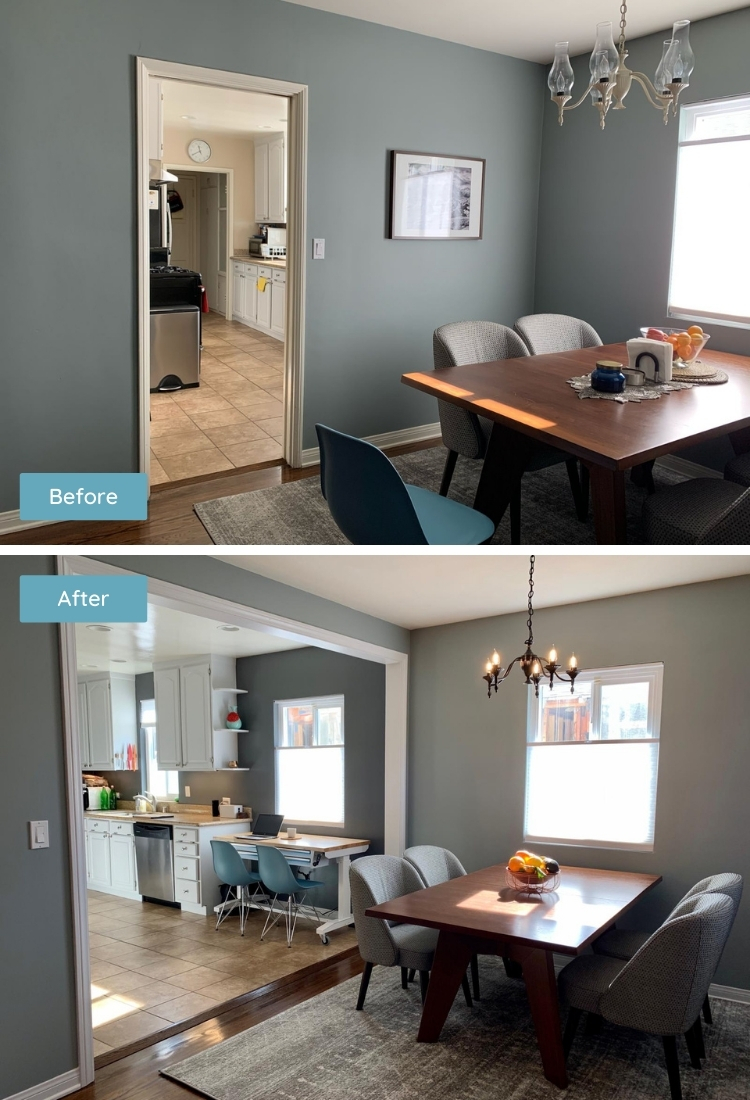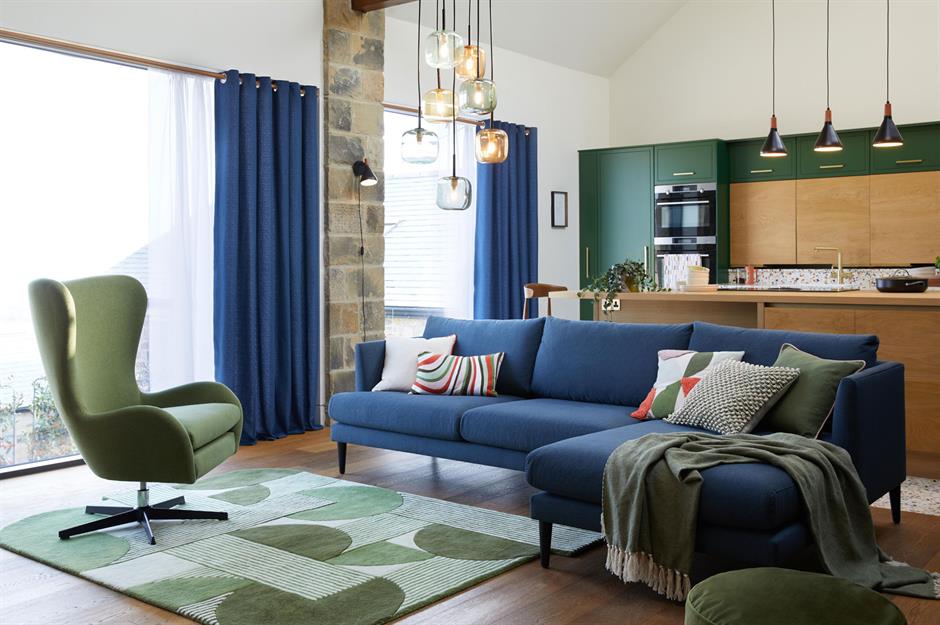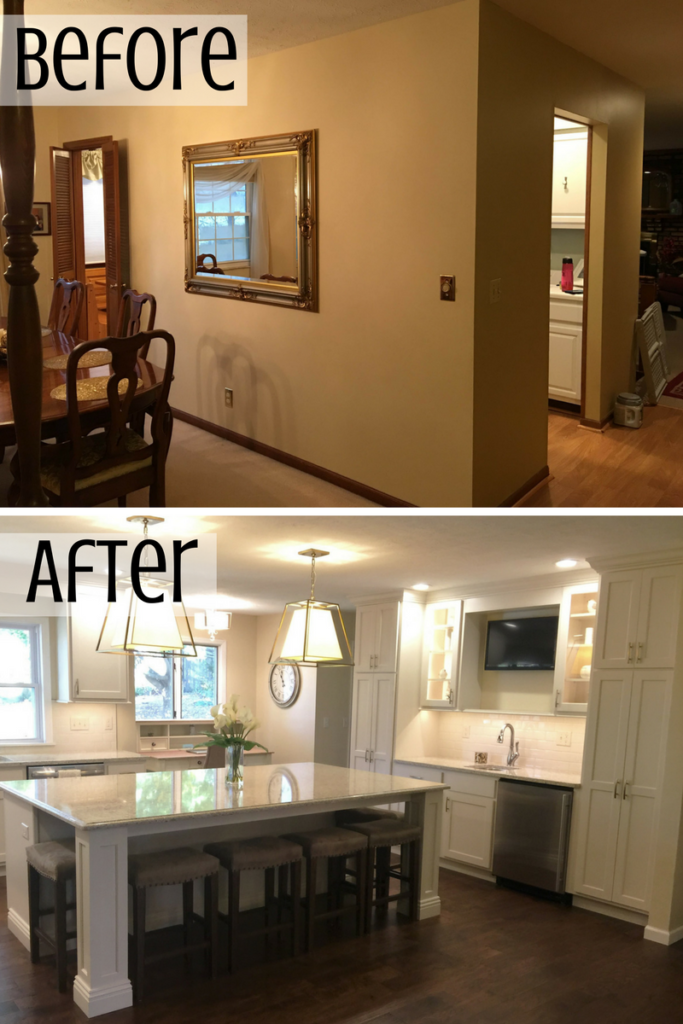Kitchen & Living Room: One Wall, Endless Style!
Kitchen & Living Room: One Wall, Endless Style!
The open-plan concept has revolutionized modern home design, blurring the lines between living spaces and creating a sense of fluidity and interconnectedness. One of the most popular manifestations of this trend is the kitchen-living room combo, where these two vital areas share a common wall, often serving as a visual and functional centerpiece.
While this layout offers unparalleled versatility and a feeling of spaciousness, it also presents a unique design challenge: how to harmoniously blend the distinct personalities of the kitchen and living room within a single, shared space. This is where the kitchen-living room wall becomes an epicenter of design ingenuity.
This wall is more than just a structural element; it's a blank canvas for creativity, a stage for showcasing your personal style, and a practical divider that can seamlessly integrate two distinct functionalities.
This blog post delves into the world of kitchen-living room wall design, exploring various strategies, trends, and practical considerations to help you create a space that is both visually stunning and functionally efficient.
Understanding the Kitchen-Living Room Dynamic
Before we dive into specific design solutions, it's essential to understand the fundamental dynamic between the kitchen and living room. These two spaces, though interconnected, have distinct purposes:
- Kitchen: This is the heart of the home, a space for cooking, preparing food, and often, entertaining. It needs to be functional, practical, and visually appealing, with ample storage and work surfaces.
- Living Room: This is the space for relaxation, socializing, and entertainment. It should be comfortable, inviting, and reflect your personal style.
The shared wall becomes the bridge between these two distinct worlds, a space where functionality meets aesthetics and practicality marries personality.

Design Strategies for the Kitchen-Living Room Wall:
1. The Power of Color and Texture
The kitchen-living room wall is an excellent opportunity to create visual interest and a sense of flow. You can use contrasting colors to visually separate the two spaces or opt for complementary hues that create a harmonious blend.

- Bold Contrast: Consider painting the kitchen side in a vibrant hue like a bold blue or sunny yellow, while painting the living room side in a calming neutral like gray or beige. This creates a distinct visual separation while maintaining a cohesive look.
- Complementary Colors: Using complementary colors, such as blue and orange or green and red, can create a sense of visual balance and depth. Consider painting the kitchen side in a cool hue and the living room side in its complementary warm shade.
- Texture Play: Introduce textured elements like wallpaper, brick accents, or wood panels to add dimension and visual interest to the shared wall. A textured wallpaper in the living room can create a cozy and inviting atmosphere, while a sleek tile backsplash in the kitchen can add a touch of sophistication.
2. Clever Storage Solutions
The kitchen-living room wall presents a prime opportunity for smart storage solutions that benefit both spaces.

- Open Shelving: Open shelving can provide much-needed storage in the kitchen while also serving as a display area for decorative items in the living room. Consider using floating shelves that extend from the kitchen wall into the living room, creating a seamless visual flow.
- Built-in Cabinets: If space allows, consider incorporating built-in cabinets that span the entire wall. The kitchen side can be used for appliances, cookware, and pantry items, while the living room side can be used to display books, artwork, or entertainment equipment.
- Multi-Purpose Furniture: Utilize furniture pieces that offer storage and function for both areas. A console table with drawers can provide storage for living room essentials while doubling as a buffet for serving food in the kitchen.
3. Functional and Stylish Separators
While the open-plan layout is all about fluidity, sometimes a subtle visual separation between the kitchen and living room can enhance the overall aesthetic and functionality.

- Curtains: A flowing curtain hung from the ceiling can be a beautiful and versatile separator. You can draw the curtains for privacy or allow them to cascade open to create a sense of openness. Consider using a fabric that complements the color scheme and overall style of the room.
- Room Dividers: Stylish room dividers, made from wood, metal, or fabric, can be placed strategically to divide the space without blocking light. Choose a divider that complements the design elements of both the kitchen and living room, allowing it to blend seamlessly.
- Bar Cart: A bar cart placed strategically on the shared wall can serve as both a functional beverage station and a visually appealing focal point.
4. Focusing on Focal Points
A focal point on the kitchen-living room wall can draw attention and create a sense of balance. This could be a dramatic fireplace with a mantel, a stunning artwork display, or a large window offering panoramic views.

- Fireplace: A fireplace creates a cozy atmosphere and acts as a natural divider between the two spaces. Consider adding a mantel above the fireplace for displaying decorative items or storing essentials.
- Artwork: A large-scale artwork or a gallery wall of smaller pieces can be a focal point in the living room, while a statement backsplash behind the kitchen sink can become a stunning focal point in the kitchen.
- Window: A large window overlooking a beautiful view can be a natural focal point, allowing natural light to flood the space.
5. Lighting Strategy for Harmony
Lighting plays a crucial role in creating the right ambiance and highlighting specific features of the kitchen-living room wall.

- Layer Lighting: Use a combination of ambient, task, and accent lighting to create a balanced and functional illumination.
- Pendant Lights: Pendant lights can add a touch of elegance and style to the kitchen area while simultaneously providing task lighting over the countertop or island.
- Wall Sconces: Wall sconces can add a soft glow to the living room, highlighting artwork or architectural features.
Styling the Kitchen-Living Room Wall
Once you've established the foundation for your kitchen-living room wall with structural elements, colors, and lighting, it's time to add the finishing touches that reflect your personal style.

1. Wall Art and Decor
- Mirror Placement: Mirrors can create a sense of space and reflect light, making the area feel larger and brighter. Consider using a large mirror to visually expand the living room or a collection of smaller mirrors to add a touch of whimsy.
- Artwork Selection: Choose artwork that complements the style of both spaces. Abstract art can work well in both modern and traditional settings, while nature-inspired pieces can bring a sense of tranquility to the room.
- Creative Displays: Arrange decorative items, such as candles, plants, books, or sculptures, on shelves, mantels, or tables to add personality and interest to the wall.
2. Furnishing the Space

- Furniture Arrangement: Choose furniture pieces that create a balanced and functional layout in both spaces. Consider using furniture with a similar style and color palette to create a cohesive look.
- Comfortable Seating: Ensure comfortable seating for both areas. A large sofa or sectional in the living room can be complemented by bar stools at the kitchen island for casual dining or entertaining.
- Rug Selection: A rug can define the living room area and add a layer of warmth and texture to the space. Choose a rug that complements the color scheme and style of the room.
3. Maintaining a Balanced Aesthetic
- Visual Coherence: Ensure that the style and color palette of both spaces are visually cohesive. Consider using a consistent color scheme throughout the room, with subtle variations in hue or intensity.
- Furniture Selection: Choose furniture pieces that have a similar style or design elements to create a cohesive look. For instance, if your living room features a mid-century modern sofa, consider using a kitchen island with a similar style or incorporating vintage bar stools.
- Consistent Materiality: Incorporate similar materials throughout the space, such as wood, metal, or glass, to create a sense of visual continuity. For example, use a wood countertop in the kitchen and a wood coffee table in the living room to tie the two areas together.

Tips for Creating a Functional and Stylish Kitchen-Living Room Wall:
- Consider Your Lifestyle: The design of your kitchen-living room wall should reflect your lifestyle and needs. If you frequently entertain, consider incorporating a bar cart or a large kitchen island with seating for guests.
- Prioritize Functionality: Ensure that the layout and design of the wall provide adequate functionality for both the kitchen and living room. Consider the placement of appliances, work surfaces, and storage space.
- Don't Be Afraid to Experiment: The kitchen-living room wall is an opportunity to experiment with different design elements and personalize your space. Try different colors, textures, and materials to create a look that is uniquely yours.
- Seek Professional Guidance: If you are unsure about the design of your kitchen-living room wall, consider consulting with a professional interior designer or architect for personalized advice and guidance.
Conclusion

The kitchen-living room wall is a dynamic element of modern home design, offering a unique opportunity to showcase personal style, create a seamless flow between spaces, and maximize functionality. By incorporating clever storage solutions, implementing a well-thought-out lighting plan, and choosing furnishings that enhance the overall aesthetic, you can transform this shared wall into a beautiful and functional centerpiece for your home. Remember, the most important thing is to create a space that reflects your personality and lifestyle, a space that you truly love to live in.
Kitchen & Living Room: One Wall, Endless Possibilities!
The open floor plan has become a staple in modern home design, blurring the lines between separate spaces and creating a sense of fluidity and openness. This trend has led to a popular architectural feature: the kitchen & living room wall. This single wall acts as a dynamic divider, offering both connection and separation between two essential areas of the home.

This shared wall presents a unique opportunity for homeowners and designers to embrace a multifunctional approach. It becomes a canvas for creativity, allowing you to blend the functionality of the kitchen with the comfort of the living room, all while maintaining a sense of distinct spaces.
The Advantages of a Shared Wall:
- Increased Space & Light: By removing a physical barrier, the open layout creates a more spacious and airy feel, maximizing natural light flow.
- Flow & Connectivity: The seamless transition fosters a sense of community and connection, ideal for families or entertaining guests.
- Multifunctional Design: This shared wall can be strategically designed to accommodate both kitchen and living room needs, offering efficiency and versatility.
- Cost-Effective: Removing a wall can save on building materials and construction costs, making it an economical choice.

Designing the Perfect Kitchen & Living Room Wall:
1. Functionality & Flow:
- Define the Zones: Consider the specific needs of each space. Kitchen appliances and cooking surfaces should be clearly demarcated from the living room area dedicated to relaxation and socializing.
- Traffic Flow: Design the layout to facilitate smooth movement between both areas, minimizing congestion and ensuring comfortable use.
- Focal Point: Determine the focal point of the living room. Is it a fireplace, a television, or a unique piece of furniture? Ensure this focal point remains prominent and accessible.

2. Visual Elements:
- Color Palette: Choose a color scheme that seamlessly blends both spaces. Consider using complementary hues or shades of the same color for a cohesive look.
- Materials & Finishes: Explore contrasting materials to visually distinguish the kitchen and living room. For instance, a sleek, modern kitchen with stainless steel appliances could contrast beautifully with warm wood tones in the living room.
- Texture & Pattern: Adding texture through materials like exposed brick, stone, or textured wallpaper can create visual interest and depth. Experiment with subtle patterns to add character and personality to the wall.
3. Furnishings & Decor:

- Furniture Arrangement: Choose furniture that complements the flow of the space and creates distinct zones. Consider a sofa or sectional facing the living room focal point, while incorporating bar stools or a breakfast nook in the kitchen area.
- Lighting: Incorporate a multi-layered lighting plan to enhance both function and ambiance. Pendant lights over the kitchen island can provide task lighting, while wall sconces in the living room can create a cozy atmosphere.
- Decor: Art, mirrors, and decorative elements can enhance the visual appeal of the wall, adding personality and reflecting your individual style.
4. The Wall Itself:
- Open Concept: A full, open wall can be visually striking, showcasing the interconnectedness of the spaces.
- Partially Divided: Consider a partial wall with built-in shelving or a fireplace to create separation while preserving a sense of openness.
- Sliding Doors: Incorporate sliding doors for privacy when desired, offering the flexibility to create a distinct living room space when needed.

Creative Ideas for the Kitchen & Living Room Wall:
1. The Kitchen Island as a Bar: Extend the kitchen island into the living room, creating a dedicated bar area for entertaining or casual gatherings.
2. Open Shelving for Display: Utilize open shelving to display books, decorative items, or serve as a wine rack, adding visual interest and creating a dynamic space.

3. Accent Wall with Wallpaper or Tile: Create a statement with a bold accent wall in the living room, utilizing patterned wallpaper or unique tile work to add depth and personality.
4. Built-in Fireplace: Incorporate a fireplace as the centerpiece of the shared wall, providing warmth and ambiance to both spaces.
5. The Wall as a Gallery: Create a gallery wall featuring family photos, artwork, or inspiring quotes, transforming the shared wall into a personal and engaging space.

6. Integrated Seating: Include built-in seating along the wall, utilizing banquette seating or comfortable benches, creating a cozy nook for reading or casual conversation.
7. The Wall as a Window: Incorporate large windows or French doors that open to a backyard or garden, bringing the outdoors in and creating a connection to nature.

Conclusion:


The kitchen & living room wall offers a wealth of possibilities for creating a functional and visually captivating space. By understanding the key design elements and embracing creative ideas, you can transform this shared wall into a masterpiece that seamlessly blends the essence of both rooms, fostering a comfortable and stylish living environment. Remember, the possibilities are truly endless! .

